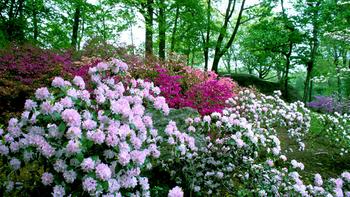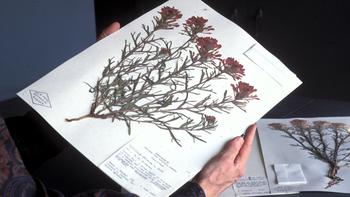In the mid-1890s, a botanist from Columbia University, Nathaniel Lord Britton, toured three locations in the Bronx. He visited land which is now Van Cortland Park and the Bronx Zoo, but he was not satisfied. When Britton saw the exposed rock outcroppings, large hills and deep valleys populated with Eastern Hemlock, Sugar Maples, Gum trees and Conifer and Hardwood trees at the New York Botanical Garden’s current location, he knew he’d found the perfect spot.
“He chose the site that he chose instantly, and with great enthusiasm, because this site included both the Bronx River, a 50-acre old-growth forest, and, surrounding the river and the forest were a series of old farms and estates that provided the perfect conditions for growing a diversity of plants from around the world,” says Todd Forrest, the Vice President for Horticulture and Living Collections at the New York Botanical Garden.
The land Britton had chosen belonged to the city, but officials agreed to transfer the 250 acres of land along the Bronx River if supporters could raise the first $250,000 to begin construction of the garden. By 1895, they had the money they needed and construction was underway.
The idea of opening a botanical garden in New York City came from a group of prominent botanists from the Torrey Botanical Society who believed that North America needed something like the Kew Gardens in London.
Dennis Stevenson, the Vice President for Botanical Sciences, says the founders wanted to populate the garden with dried specimens as well as live ones to study the physiology of how plants reproduce, and to “push botanical science forward, utilizing the most modern ways of doing things and that involved collecting the world's flora so that we could discover and describe new species and understand where they were in time and space.”
The mission of the museum was three-fold, focusing on: plant science, horticulture and education. “This was the first traditional multi-faced botanical garden on a grand scale in any U.S. city,” Forrest says. But the founders also wanted to “create a beautiful escape in the middle of the city.”
Today, the garden still places great emphasis on collecting live and dried specimens from around the world. While universities have placed more emphasis on molecular biology, “the botanical garden has become the botanical department for the New York City area,” Stevenson says.
The garden has also changed with the times and currently employs about 41 scientists and about 40 PhD candidates from local colleges who conduct research on DNA extraction and mapping the genome of plants, among other projects.
There is also an “economic botany” program that focuses on sustainable agricultural practices, like figuring out how to develop 60 acres of a 600,000-acre rainforest while providing for local communities and leaving minimal impact on the native plants and wildlife.
They also partner with Bronx Science High School and receive grants from the National Science Foundation. “You don’t build a garden and just look at it,” Forrest says. “Gardens are always changing. And this garden, these 250 acres, since 1895 has also been changing.”
The garden has five exhibits a year, including the Orchid Show, and they are in the midst of planting 3,000 azaleas in an 11-acre stretch in the center of the garden. And, its 50 acres of primeval forest that include views of the Bronx River and a waterfall are open to the public.
“It’s impossible to conceive that you are in the middle of New York City...that you’re in the middle of the Bronx. It’s so natural and so beautiful that it really is a shock to people who haven’t seen it and don’t expect it," Forrest says. "Makes you forget instantly that you are in the city."



